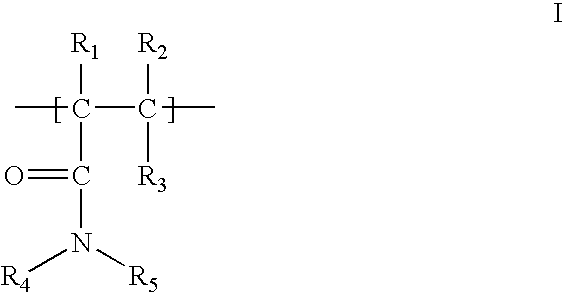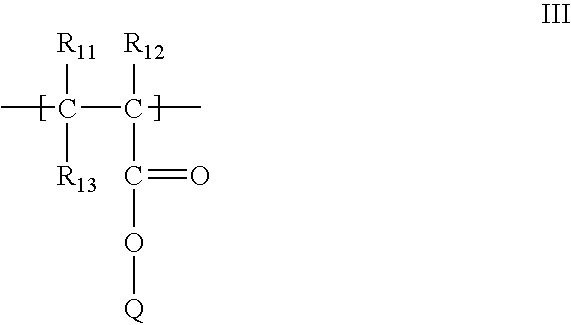Bio-synthetic matrix and uses thereof
a bio-synthetic matrix and matrix technology, applied in the field of tissue engineering, can solve the problems of complex structure, insufficient robustness of natural polymer matrix, and difficulty in obtaining seamless host-implant interface and complete integration of hydrogel implant into the host,
- Summary
- Abstract
- Description
- Claims
- Application Information
AI Technical Summary
Benefits of technology
Problems solved by technology
Method used
Image
Examples
example 1
Preparation of a pNiPAAm-Collagen Hydrogen
[0151] A pNiPAAm-collagen hydrogel was prepared to provide an alternative hydrogel against which the properties of the hydrogels of the present invention could be compared.
[0152] A 1 wt / vol % solution of pNiPAAm homopolymer in ddH2O was sterilised by autoclaving. This solution was mixed with sterile RTT collagen solution [3.0-3.5 mg / ml (w / v) in acetic acid (0.02N in water] (1:1 vol / vol) in a sterile test tube at 4° C. by syringe pumping to give complete mixing without bubble formation. Cold mixing avoids any premature gelification or fibrilogenesis of the collagen. The collagen-pNiPAAm was then poured over a plastic dish (untreated culture dish) or a mould (e.g. contact lens mould) and left to air-dry under sterile conditions in a laminar flow hood for at least 2-3 days at room temperature. After drying to constant weight (˜7% water residue), the formed matrix was removed from the mould. Removal of the matrix from the mould is facilitated ...
example 2
Preparation of a Synthetic Terpolymer
[0153] A collagen-reactive terpolymer, poly(NiPAAm-co-AAc-co-ASI) (FIG. 1), was synthesised by co-polymerising the three monomers: N-isopropylacrylamide, (NiPAAm, 0.85 mole), acrylic acid (AAc, 0.10 mole) and N-acryloxysuccinimide (ASI, 0.05 mole). The feed molar ratio was 85:10:5 (NiPAAm: AAc: ASI, the free-radical initiator AIBN (0.007 mole / mole of total monomers) and the solvent, dioxane (100 ml), nitrogen purged before adding AIBN. The reaction proceeded for 24 h at 65° C.
[0154] After purification by repeated precipitation to remove traces of homopolymer, the composition of the synthesised terpolymer (82% yield) was found to be 84.2:9.8:6.0 (molar ratio) by proton NMR in THF-Dg. The Mn and Mw of the terpolymer were 5.6×104 Da and 9.0×104 Da, respectively, by aqueous GPC.
[0155] A solution of 2 mg / ml of the terpolymer in D-PBS remained clear even up to 55° C., consistent with a high LCST. A solution of 10 mg / ml in D-PBS became only slightly ...
example 3
Preparation of a Synthetic Polymer Comprising a Bioactive Agent
[0156] A terpolymer, containing the pentapeptide YIGSR (SEQ ID NO: 1) (a nerve cell attachment motif), was synthesised by mixing the terpolymer prepared in Example 2 (1.0 g) with 2.8 μg of laminin pentapeptide (YIGSR (SEQ ID NO: 1)), from Novabiochem) in N,N-dimethyl formamide. After reaction for 48 h at room temperature (21° C.), the polymer product was precipitated out from diethyl ether and then vacuum dried. ASI groups remaining after reaction with the pentapeptide are available for subsequent reaction with collagen. The structure of this polymer is shown in FIG. 8A.
PUM
| Property | Measurement | Unit |
|---|---|---|
| diameters | aaaaa | aaaaa |
| physiological temperatures | aaaaa | aaaaa |
| LCST | aaaaa | aaaaa |
Abstract
Description
Claims
Application Information
 Login to View More
Login to View More - R&D
- Intellectual Property
- Life Sciences
- Materials
- Tech Scout
- Unparalleled Data Quality
- Higher Quality Content
- 60% Fewer Hallucinations
Browse by: Latest US Patents, China's latest patents, Technical Efficacy Thesaurus, Application Domain, Technology Topic, Popular Technical Reports.
© 2025 PatSnap. All rights reserved.Legal|Privacy policy|Modern Slavery Act Transparency Statement|Sitemap|About US| Contact US: help@patsnap.com



